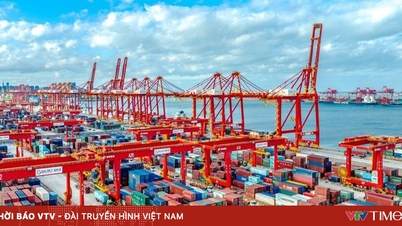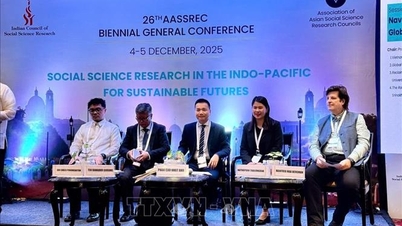 |
| Illustrative image. (Source: Bloomberg) |
In its latest report on the global economy, the World Bank (WB) forecasts that Asia – one of the world's main growth engines – will experience its slowest growth rate since the late 1960s, excluding extraordinary events such as the Covid-19 pandemic, the Asian financial crisis, and the global oil shock of the 1970s.
Gloomy forecast for 2024
The World Bank lowered its growth forecast for China and warned that developing economies in East Asia will grow at their slowest pace in 50 years, as US protectionism and rising public debt hinder growth.
The World Bank's bleak economic forecast for 2024 underscores growing concerns about a slowdown in China and the risk of it spreading to Asia. Chinese policymakers set one of the lowest growth targets in decades for 2023 at around 5%.
For years, US-China trade tensions and tariffs imposed by the US on Asia's number one economy have fueled import demand from other countries in the region. However, the US enactment of the Inflation Reduction Act (IRA) and the Chips & Science Act in 2022 – policies aimed at boosting US manufacturing and reducing US dependence on China – has indirectly impacted Southeast Asian countries.
Exports of products affected by the law from the region to the US have decreased significantly. Meanwhile, Asia has long thrived, even achieving "miracles" thanks to trade and investment in manufacturing. Weaker global demand is having its consequences. Rising household, corporate, and government debt is dampening growth prospects.
According to an analysis by Aaditya Mattoo, the World Bank's economist for East Asia and the Pacific, Southeast Asia, which had already benefited from the US-China trade tensions due to trade diversion, is now suffering the consequences of that very shift.
WB data shows that reduced demand due to slowing global growth is affecting all countries. In particular, exports of electronics and machinery from China and Southeast Asian countries, including Indonesia, Vietnam, the Philippines, Malaysia, and Thailand, have fallen sharply following the implementation of President Joe Biden's protectionist policies.
These increasingly bleak forecasts reflect that much of Asia, not just China, is beginning to feel the impact of new U.S. policies under the IRA Act and CHIPS & Science.
When China sneezes, all of Asia catches a cold.
The Financial Review (Australia) recently issued a warning about a "domino effect" in Asia. According to the report, China's slowing growth, driven by weakening consumer demand and slowing manufacturing activity, is negatively impacting neighboring countries closely linked to the world's second-largest economy.
The decline in manufacturing in South Korea has lasted for almost the longest period in nearly half a century. The fourth-largest economy in Asia, considered a hub for the region's technology supply chain, has helped bolster global growth for decades.
However, the country's exports in July 2023 fell at the fastest rate in more than three years, led by a drop in computer chip exports to China. Meanwhile, recent figures show that factory activity declined in August 2023, marking the 14th consecutive month of declines and the deepest drop in history.
Figures from Japan, where manufacturing activity declined for the fifth consecutive month, reflect lower factory output and weaker overseas demand.
Concerns have been mounting in recent weeks, following the Chinese economy's fall into deflation, raising worries about a range of issues from weak consumer spending, a weakening currency, a shaky real estate sector, and unsustainable local government debt.
According to official data, as global demand slows, the Chinese economy is further struggling, evidenced by the fact that its manufacturing sector contracted for the fifth consecutive month in August 2023.
Analyst Vincent Tsui of the Gavekal Research Group in Beijing describes the current situation as "when China sneezes, all of Asia catches a cold." He argues that with policymakers in Beijing ignoring calls to boost weakening growth through stimulus measures, the consequences will be felt across the region.
Expert Tsui warns that the commercial and financial centers of Hong Kong (China) and Singapore are most vulnerable, as Chinese demand accounts for 13% and 9% of Hong Kong's and Singapore's GDP, respectively.
Park Chong-hoon, head of research at Standard Chartered in Seoul, South Korea, believes that South Korea is unlikely to recover anytime soon unless the Chinese economy rebounds rapidly. He points to challenges stemming from US-China tensions and the trend of China replacing imports.
In Southeast Asia, Vietnam's exports in the second quarter of 2023 fell by 14.2% year-on-year, indicating a slowdown in industrial production this year. Malaysia's growth rate was the slowest in nearly two years, facing a decline in its main trading partner. Thailand's economy grew at a much slower pace than expected in the second quarter of 2023, due to domestic political instability and low tourist numbers from China.
Analysts at Gavekal Dragonomics warn that as the Chinese economy weakens, foreign suppliers who have thrived in providing raw materials and machinery will face difficult times. Furthermore, the collapse of the Chinese real estate market will not reverse quickly, and the situation could worsen.
According to World Bank expert Aaditya Mattoo, the growth rate of Asian countries will continue to be hampered until their governments, including China, implement deep reforms in the services sector, taking advantage of the digital revolution.
Source












































































































Comment (0)